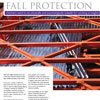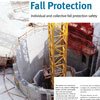What is collective protection
What is personal protection
Why give priority to collective measures
Last resort
Competence
Working Environment
Access and Egress
Duration and frequency of use
Fragile roofs
Consequences of a potential fall
Maintenance
Inspections
Emergency rescue
Installation and removal
Introduction
Falls are the biggest cause of deaths in the workplace and it is easy to see why reducing the number of falls from height is a priority and principally due to the lack of proper edge protection in a variety of tasks. In construction falls from height accounts for more than half of all deaths in the industry every year, and a significant amount of all major and lost time injuries.

OSA Fall Protection magazine
The most frequent problem is inadequate scaffolding, with no proper access or no guard rails to prevent falls. Scaffolding is often erected by unqualified operatives, and is sometimes improvised, using unsuitable materials. Apart from scaffolding problems, other causes of falls include unprotected openings in buildings, lack of edge protection in roof work, lack of crawling boards on fragile roofs, demolition work and inappropriate use of ladders and hoists.
The poor selection, use and maintenance of equipment causes falls, for example, using a ladder because it’s easier than erecting a tower scaffold. Ladders should only be used for low risk, short duration work, for example, work which takes minutes not hours to complete and where 3 points of contact can be maintained at all times.
Research in the UK shows
- 35 fatal incidents in 2008/09 and a total of 421 since 2001
- Cause of 4589 major injuries 2008/09
- 87% of all major injuries are caused by ‘low falls’ (i.e. below 2 meters)
The 87% of major injuries caused by falls from height of below 2 meters are commonly from a ladder. Traditionally, significant risk concerning working at height has begun with work where the potential fall has been 2 meters or more but the figure above regarding major injuries proves this was a mistake.
Read the rest of this entry »


